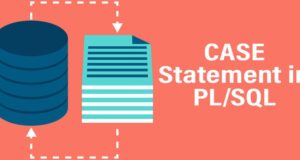REQUEST COMPLIMENTARY SQLS*PLUS LICENCE
Oracle CASE statement

In Oracle statement CASE has IF-THEN-ELSE functionality. Starting with Oracle 9i, you can use a CASE statement in an SQL sentence.
Syntax of CASE statement
CASE [ ]
WHEN condition_1 THEN result_1
WHEN condition_2 THEN result_2
…
WHEN condition_n THEN result_n
ELSE result
END
Parameters and arguments of the CASE statement
- expression is not mandatory. It is a value that you compare to conditions (that is: condition_1, condition_2 … condition_n).
- condition_1 … condition_n must be of the same type. Conditions are evaluated in order, one after another. After the condition takes the value TRUE (truth), the CASE operator returns the result and will not evaluate the conditions further.
- result_1 … result_n all must be of the same data type. This value is returned once the condition assumes TRUE (True).
Note:
- If the condition does not accept TRUE, the CASE operator will return the ELSE offer.
- If the ELSE offer is omitted and the condition does not accept TRUE, the CASE operator will return NULL.
- The CASE operator can have up to 255 comparisons. Each WHEN … THEN sentence considers 2 comparisons.
You can use the CASE statement in the following versions of Oracle / PLSQL:
| Oracle 12c, Oracle 11g, Oracle 10g, Oracle 9i |
You can use a CASE statement in an SQL sentence as follows:
SELECT table_name,
CASE owner
WHEN 'SYS' THEN 'The owner is SYS'
WHEN 'SYSTEM' THEN 'The owner is SYSTEM'
ELSE 'The owner is another value'.
END
FROM all_tables;
Or you could write an SQL query using the CASE statement as follows: (omitting WHEN … THEN in the sentence). For example:
SELECT table_name,
CASE
WHEN owner='SYS' THEN 'The owner is SYS'
WHEN owner='SYSTEM' THEN 'The owner is SYSTEM'
ELSE 'The owner is another value'.
END
FROM all_tables;
These two examples of CASE statement are equivalent to the following conditional IF-THEN-ELSE statement:
IF owner = 'SYS' THEN
result := 'The owner is SYS';
ELSIF = 'SYSTEM' THEN
result := 'The owner is SYSTEM';
ELSE
result := 'The owner is another value';
END IF;
The CASE operator will compare each value of the owner, one after the other.
The ELSE offer in a CASE operator is optional. It can be omitted. Let’s look at a previous SQL query with the ELSE clause omitted.
The SQL query will look like this:
SELECT table_name,
CASE owner
WHEN 'SYS' THEN 'The owner is SYS'
WHEN 'SYSTEM' THEN 'The owner is SYSTEM'
END
FROM all_tables;
With no ELSE offer, if none of the conditions accept TRUE, the CASE operator will return NULL.
Comparing 2 conditions
Here is an example that shows how to use a CASE operator to compare different conditions:
SELECT
CASE
WHEN a < b THEN 'hello'
WHEN d < e THEN 'goodbye'
END
FROM suppliers;
Comparison of 2 fields in one CASE sentence:
SELECT supplier_id,
CASE
WHEN supplier_name = 'IBM' and supplier_type = 'Hardware' THEN 'North office'
WHEN supplier_name = 'IBM' and supplier_type = 'Software' THEN 'South office'
END
FROM suppliers;
So, if the field supplier_name = ‘IBM’ and field supplier_type = ‘Hardware’, the CASE operator will return ‘North office’. If the field supplier_name = ‘IBM’ and supplier_type = ‘Software’, the CASE operator will return ‘South office’.
CASE STATEMENT(IF THEN ELSE) IN ORACLE SQL WITH EXAMPLE
MORE NEWS
PreambleNoSql is not a replacement for SQL databases but is a valid alternative for many situations where standard SQL is not the best approach for...
PreambleMongoDB Conditional operators specify a condition to which the value of the document field shall correspond.Comparison Query Operators $eq...
5 Database management trends impacting database administrationIn the realm of database management systems, moreover half (52%) of your competitors feel...
The data type is defined as the type of data that any column or variable can store in MS SQL Server. What is the data type? When you create any table or...
PreambleMS SQL Server is a client-server architecture. MS SQL Server process starts with the client application sending a query.SQL Server accepts,...
First the basics: what is the master/slave?One database server (“master”) responds and can do anything. A lot of other database servers store copies of all...
PreambleAtom Hopper (based on Apache Abdera) for those who may not know is an open-source project sponsored by Rackspace. Today we will figure out how to...
PreambleMongoDB recently introduced its new aggregation structure. This structure provides a simpler solution for calculating aggregated values rather...
FlexibilityOne of the most advertised features of MongoDB is its flexibility. Flexibility, however, is a double-edged sword. More flexibility means more...
PreambleSQLShell is a cross-platform command-line tool for SQL, similar to psql for PostgreSQL or MySQL command-line tool for MySQL.Why use it?If you...
PreambleWriting an application on top of the framework on top of the driver on top of the database is a bit like a game on the phone: you say “insert...
PreambleOracle Coherence is a distributed cache that is functionally comparable with Memcached. In addition to the basic function of the API cache, it...
PreambleIBM pureXML, a proprietary XML database built on a relational mechanism (designed for puns) that offers both relational ( SQL / XML ) and...
What is PostgreSQL array? In PostgreSQL we can define a column as an array of valid data types. The data type can be built-in, custom or enumerated....
PreambleIf you are a Linux sysadmin or developer, there comes a time when you need to manage an Oracle database that can work in your environment.In this...
PreambleStarting with Microsoft SQL Server 2008, by default, the group of local administrators is no longer added to SQL Server administrators during the...















